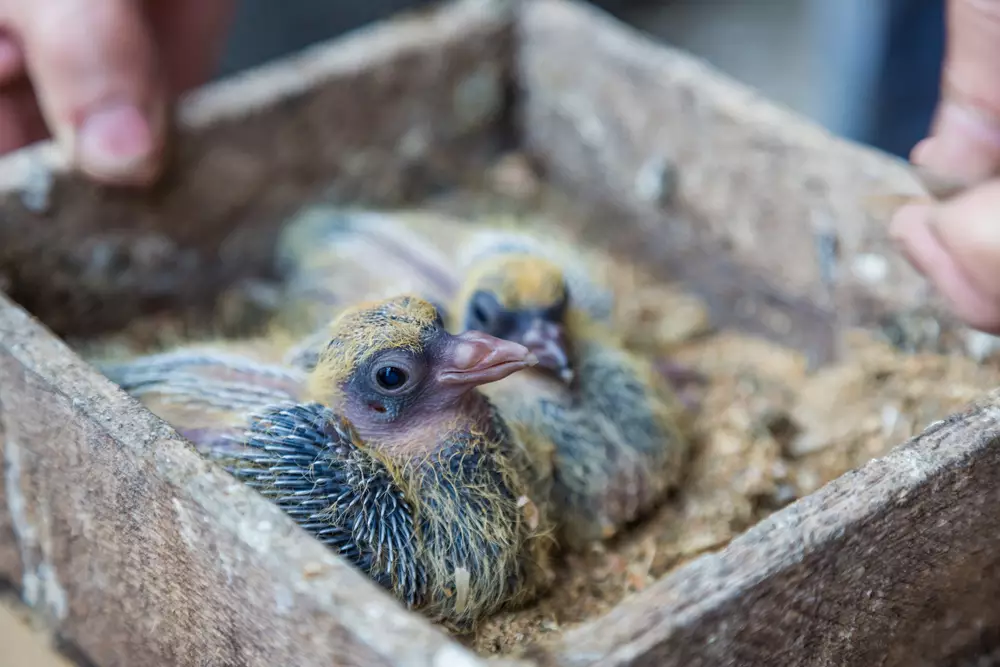As a city dweller, I often find myself sharing the urban landscape with the familiar sight of pigeons. Their constant presence is a reminder of nature’s resilience in the most human-centric of environments. However, one aspect of their existence seems shrouded in mystery. I am referring to their young ones, the baby pigeons.
The term for a baby pigeon is squab. This somewhat unusual name adds a layer of intrigue to these urban birds, inviting more exploration into their lives. A squab is generally hidden away in nests until it’s almost the same size as an adult pigeon, explaining their scarcity in public sightings.
Pigeons, and specifically squabs, have a fascinating life cycle and role within our cityscapes. Their existence prompts a series of inquiries about the pigeon’s lifecycle, their appearance, and their contribution to the urban ecosystems they inhabit.
Pigeon Life Cycle: A Quick Overview
Brief Description of the Pigeon Life Cycle
Pigeons have a fascinating life cycle that starts in an egg, which hatches after around 18 days. This is when the squab, or baby pigeon, makes its first appearance. For the first week, the squab is tiny, blind, and entirely reliant on its parents.
Age of Independence: When do Baby Pigeons Leave the Nest?
After about 30 days, squabs are fully fledged and begin to leave the nest. At this point, they’re nearly indistinguishable from adults, which is why we rarely spot younger pigeons in our urban surroundings.
The Name for a Baby Pigeon: Squab
Defining “Squab”: The Formal Term for Baby Pigeons
While we often refer to the young of many animals as “babies,” squabs have their own unique moniker. This term is primarily used in the field of aviculture and by bird enthusiasts.
Other Names: Variations Across Cultures and Languages
The name can vary across cultures and languages. For instance, in French, a baby pigeon is called “pigeonneau,” while in Spanish, they are referred to as “pichón.”

Physical Characteristics of a Squab
Distinctive Features of a Squab
Squabs have a distinctive look that sets them apart from their adult counterparts. They initially have yellowish, downy feathers and closed eyes, eventually developing flight feathers and opening their eyes around a week after hatching.
Comparison to Adult Pigeons: How They Change as They Grow
As they grow, squabs undergo a series of transformations. Their beaks, initially soft and short, lengthen and harden. Their body size increases dramatically, and by the time they leave the nest, they closely resemble adult pigeons.
Squabs in Urban Ecosystems
Role of Squabs in City Environments
Squabs, like adult pigeons, contribute significantly to the urban ecosystem. They form a link in the food chain, acting as prey for predatory birds and helping control the population of certain insects and pests by feeding on them.
Interactions with Humans and Other Animals
Their interactions with humans vary. While some view them as pests, others find joy in their presence, often feeding them in city parks.
Pigeon Parenting: Raising a Squab
Pigeon Parenting Behaviors: How They Care for Their Young
Pigeon parents are highly dedicated. Both mother and father take turns incubating the eggs and feeding the squabs a nutrient-rich substance called crop milk.
Feeding Habits: The Diet of a Squab
The diet of a squab is fascinating. For the first few days, they are fed crop milk, but as they grow, the parents gradually introduce small seeds and grains.
Squabs in Popular Culture and Cuisine
Pigeons and Squabs in Stories, Art, and Symbolism
Pigeons and squabs have a notable presence in popular culture, featuring in numerous stories and artworks. They are often symbols of peace, love, and tranquility.
The Culinary Side: Squab as a Food Source
In culinary circles, squab is a delicacy. Its tender meat is enjoyed in many cultures worldwide, prepared in various ways, from roasting to braising.
Frequently Asked Questions
How Long Does It Take for a Squab to Become a Pigeon?
A squab is typically considered a fully grown pigeon after about 30 days, at which point they look almost identical to their adult counterparts and start venturing out of the nest.
Why Don’t We See Baby Pigeons?
Squabs stay in the nest until they’re almost the same size as adult pigeons. This is why we seldom see what we’d identify as baby pigeons in public spaces.
Are Squabs Safe to Touch?
It’s best not to handle squabs unless absolutely necessary, as their parents might abandon them if they detect the scent of humans.
Conclusion
To sum up, squabs, or baby pigeons, play a noteworthy role in our urban landscapes. The secretive nature of their early lives and the care their parents provide offer a glimpse into the compelling world of these commonly seen yet often overlooked birds.
Their existence in our cities is a testament to nature’s adaptability. They have found ways to thrive alongside humans, adding a touch of the wild to our often-concrete surroundings.
In closing, the next time you spot a pigeon, consider its life cycle, the care it received as a squab, and the role it plays in the ecosystem. These feathered city dwellers have fascinating stories to tell, and we have much to learn from their resilience and adaptability.